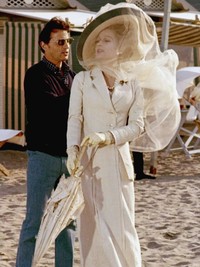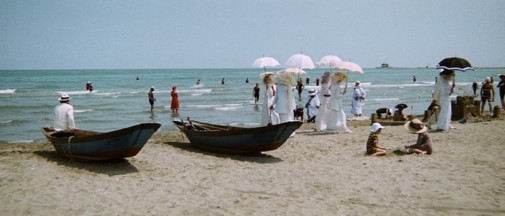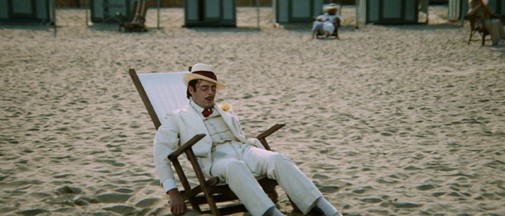Death in Venice @50: Piero, I love you
 Thursday, March 4, 2021 at 10:30AM
Thursday, March 4, 2021 at 10:30AM For a cinephile, costume enthusiast, and Oscar obsessive like myself, there are few things more enticing than the lone nominee. That elusive movie that gets nominated only for the Best Costume Design statuette. Such is the case of Luchino Visconti's adaptation of the Thomas Mann novel Death in Venice. To celebrate the film's 50th anniversary, I decided to explore that wondrous wardrobe that caught AMPAS' collective eye. It's one of the best works of Piero Tosi, a man who may have been the greatest costume designer to ever create for film.
After five unsuccessful Oscar nominations, Piero Tosi won an Honorary Academy Award in 2014, the first costume designer to ever do so. It couldn't have happened to a more deserving artist...
He wasn't only a human-sized god of costume design either. Tosi also conceived hair for Luchino Visconti's The Damned, the grotesque makeup of Federico Fellini's Satyricon, and the sets of his Toby Dammit short, among other credits. Throughout his career, the man worked for some of the best Italian directors of his time. The aforementioned Fellini and Visconti, as well as De Sica, Pasolini, Bolognini, Cavani, Monicelli, and Zeffirelli are all names one can find in Tosi's filmography. Still, maybe more important and notable than any of these lofty associates was Tosi's collaboration with Tirelli Costumi, a legendary costume house.
Through his work with Umberto Tirelli, Piero Tosi was able to source vintage clothing and find a level of craftsmanship that made possible such behemoths of period costume design as Luchino Visconti's last few films. Tosi's devotion to period accuracy went as far as cutting the fabrics according to the widths manufactured in times immemorial. Such things affect the seaming, the number and cutting of pattern pieces, and, ultimately, how the fabric behaves as it falls over the body. Beyond that, historical accuracy is needed to properly evoke societal order, its mores, and unspoken rules, concepts made visible through the clothes people wear. Costume design is thus one essential tool of worldbuilding, its storytelling properties far exceeding that of the simple ornament.
The ultimate purpose of this fidelity and attention to detail is the total immersion of the viewer within another world. Sharing a similar attitude, Piero Tosi found his perfect match in Luchino Visconti, Duke of Modrone, who, like the costumier, was one-of-a-kind. As an aristocrat who grew in an environment that venerated the opulence of the past, he was equipped to film the wealthy yesterday like few others. However, he was also an avowed communist, so his recreations of the noblesse were always infused with a critique both savage and surgically accurate. Then, there's the matter of his queerness. It was an open secret making the man an outcast both to his class and the communist party which wasn't opposed to revoking memberships because of such sexual dalliances.
An outsider and an insider, Visconti became a lover of artifice. One can always feel how he unpeels its many layers in his films, especially the period pieces. Those movies, all of them costumed by Tosi, are both ephemeral and bluntly material. The narratives unravel in memory plays, apparitions invoked by the characters' moody ennui, the artifice of aristocratic lifestyles, a metaphorical atmosphere so thick it suffocates. Nonetheless, their environments, their lives, are palpable and realistic. If anything, this paradoxically makes them more unreal and haunting. We can picture these detailed cosmoses as they were, but we also recognize they've been obliterated by time. When we can feel the past so viscerally, its present non-existence is akin to a ghoulish ghost screaming at us. As gorgeous as it is terrifying.
Gorgeous and terrifying is indeed a good descriptor of Death in Venice. The 1971 film tells the sad tale of Gustav von Aschenbach, a middle-aged artist traveling to Venice for health reasons. Despondent over the loss of a child and professional failure, he becomes fixated on an adolescent boy, Tadzio. He's the son of a wealthy Polish family staying in the same hotel as Aschenbach, and comes to be something akin to a symbolic culmination of beauty. He is the golden promise of youth, the perfection of art given natural form. That's how the older man, the pederast, sees him, at the very least. It's, in fact, his unwillingness to depart from such a vision is that damns him. In the Venice of early 1910s, cholera spreads through the canals, bringing death with it. Aschenbach knows this, but he refuses to leave, refuses to stop looking at Tadzio.
We may always kill the things we love but those same beloved fixations can be our perdition too. Obsession leads to self-destruction. In Aschenbach's case, he even seems aware of this but is unwilling to change course. His lust is a death wish, a need to be destroyed by the object of desire. Death in Venice reveals itself as the story of an ascetics' reason succumbing to the beckoning of beauty, pleasure, pure devastation. Visconti's adaptation tackles the cerebral nature of these ideas, but he goes farther still, daring to make explicit what was just implicit in Mann's text. Visconti gives body to the immaterial. The cineaste's film is a visceral and cruelly ironic Death in Venice, a tragedy of the senses rather than the tragedy of the existentialist's intellect.
The transfiguration of the ineffable into solid matter is made through the décor, the makeup, the costumes. Piero Tosi's nearly fetishistic attention to detail is an integral part of his director's essential conception of Death in Venice. Like in all of the film's complex visions, there's enticing materiality to Tosi's use of textures. Smooth silk, crisp starched cottons, breezy linens, scratchy lace, all look palpable enough to touch. However, as light in the silver screen, they're out of reach and our relationship to these signs of tactility is unfulfilled longing. Like Aschenbach yearns for Tadzio, we too yearn to brush with our fingers these brilliant surfaces.

While it feels wrong to ponder such a thing, Tosi, who was recovering from a car accident at the start of the film's development, had considered turning down this job. Thankfully, Visconti convinced him to persevere and urged the designer to start working on Tadzio's costumes first. He was to be the ideal of beauty, bedecked in sailor costumes and swimsuits made of American rayon. Everything else in the movie exists in concordance or contrast to what he represents. The costumes worn by Silvana Mangano as Tadzio's mother, for instance, were later inspired and derived from photographs of Visconti's mother, Carla Elba. The taste for blush and cream tones, veils of soft silk tulle wrapping around every hat come from her. In any case, both figures are not of this reality.
Beauty, the kind of beauty the boy symbolizes and that the aristocratic attire indicates, is inherently otherworldly, unsustainable. Going further into the Polish characters, if Tadzio is ideal, his mother encapsulates the contradictions of her class, vice and elegance hand in hand. Her wardrobe is a good synecdoche of Tosi's general philosophy towards period costuming, all its idiosyncrasies. The designs of this master are reverential of past fashions, of course, but also seem open to acknowledging their absurdities, constrictive styles, stifling cornucopias of accessories and accouterments. They are museum-worthy all while refusing to be ignorant of their oddity to modern eyes.
Regarding more logistical matters, it should be noted that not every piece of this wardrobe is historical reconstruction. Some are artifacts from the early 1910s like Bogarde's raw silk summer suit. It's a testament to Tosi's craft that he can mix and match authentic period pieces with costumes and nobody can tell the difference. While a lot of walking suits and tea gowns worn by the women were antiques, the evening wear and all the beach garments had to be made from scratch, their materials as exact as their silhouette. This last element is necessary to the understanding of the flashback structure that sees traumatic memories forcing their way into the now. The démodé looks clash as does the color story. Whether coppery tans or a burst vermillion, they contaminate the black and white world of the Lido di Venezia.

Color-wise, it's impossible to overstate the role of white in the film's visual narrative. Death is everywhere and the streets are soaked in milky chemicals to kill the pestilence. White is the makeup smudged over the faces of old men and disease-riddled vagabonds, the linens and scratchy laces soaked in sweat that try and fail to mask the bloody mess of the human body. You can put all the pearly silk you want over a walking corpse but you won't be able to hide the necrosis for long. The stench of old flesh will permeate even the most expensive textiles. White's also an exclusive color. Only the rich have the wealth to maintain and launder any article of white cloth that's not undergarments. The dispossessed, in contrast, are always in muddy brown, faded black, and dirty greys. They're the shadow that exists because of the others' shining privilege.
To articulate such complicated class hierarchies, every extra must be perfectly outfitted. Their costumes are as crucial to the immersive nature of the mise-en-scène as the stars' outfits. Take, as an indicator of this, the Russian families in the background of scenes at the hotel. They laugh heartily and dress a decade out of fashion, just like the ghosts of the protagonist's memories. Their old world was about to collapse in bloody revolution and yet they giggle, blissfully unaware of the death of their entire way of life. Logically, it's not only their world that's about to meet its end. All of the aristocracies will face the visage of Death once World War I erupts. Some will survive, many won't. The decadence of the Edwardian setting isn't one blossomed only from rot covered by white makeup. Much of the perfumed decay comes from the fact this outdated reality is moribund and overcompensating for it with outward shows of opulence.
Many lovers of costuming and fashion have expressed adoration for Piero Tosi's work in the film. Sandy Powell and Daniel Orlandi have both credited Death in Venice as one of the flicks that inspired them into becoming costume designers, for example. As for the fashion world, Diana Vreeland loved the film's style with a passion. The American editor used part of Tosi's period wardrobe and many pieces from Tirelli's extensive archive to construct an exhibition about the influence of French Fashion in the first decades of the 20th century. Tosi's legacy extends beyond even that. After he stopped making movies, the artist taught and a number of his students are now some of the best costume designers working today. Just look at the work of Massimo Cantini Parrini for director Matteo Garrone's Tale of Tales and last year's Pinocchio.
A master of his art, Piero Tosi's work, his influence, shall reverberate through film history forevermore. In some ways, he has done what Aschenbach couldn't. He captured beauty in all its perfection, touched it with his bare hands, and, through that artistic miracle, became immortal.

Death in Venice is streaming on the Criterion Channel. You can also find it on TCM and DirecTV.




















Reader Comments (12)
I love this movie because of its use of Mahler's music.
Death in Venice is a masterpiece and it's a shame that it was nominated for only 1 Oscar.
Not my favorite Visconti, but this is write-up is great. Like so many Piero Tosi works, well, just stunning work.
The white appears as something ethereal but also frightening, as if announcing bad omens. In fact, in the 1970s, white in costumes and sets is always something special to note, since this is known as the decade of darkness because of the usually dark cinematography.
Gays can't have a break! There's no place to run! The communist comrades who were finally going to bring the solutions, make a better and more egalitarian world - surprise! - a bunch of homophobes.
Not the best Visconti, no doubt. But a legitimate Visconti. There is a debate about Dirk Bogard to be or not too young to play the protagonist, but the director is respectful to the book that deserves to be read by those who like the movie.
It's right up there with Rocco and his brothers and The Leopard as Visconti's crowning achievements.
This is one of several films by Luchino Visconti that I want to see yet I'm fortunate to have it my DVR hard drive waiting to be watched as soon as possible. I have yet to be disappointed by Visconti having seen The Leopard, Rocco and His Brothers, and White Nights as they're all just fucking incredible.
Beautiful looking film a great example of cinema as art
Really lovely tribute to Piero Tosi, Cláudio!
I love Death in Venice and the costumes are brilliant and feel so lived-in.
Tosi and Visconti did much work at la Scala opera house with Maria Callas. So in one opera they dressed her as prima Donna in silk and satin and jewellery while the other women on stage wore similar design but in cotton a d less luxurious fabrics.
It's always exciting to read a new article article about a new movie I love. Thank you!